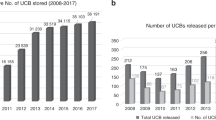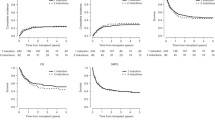Abstract
In unrelated cord blood (UCB) transplantation, survival has been shown to correlate with the degree of HLA matching. Thus, to extend transplant access to different ethnic backgrounds, many western UCB transplantation banks now encourage donation from non-Caucasians. Until recently, Saudi Arabia did not have a national UCB bank. In this study we report our experience in UCB transplantation in children using units procured from western cord blood banks. A total of 97 children underwent unrelated UCB transplantation at King Faisal Specialist Hospital and Research Center (KFSHRC), of which 95 were of Arab ethnicity. A total of 30 patients had malignant disorders, 25 patients had non-malignant hematological disorders and 42 patients had inborn errors. Conditioning was according to disease, with six patients receiving reduced-intensity regimens. In all, 46 patients received one-Ag-mismatched units and 51 received two-Ag-mismatched units. Engraftment occurred in 93% of patients, the 100-TRM was 15%, acute GVHD developed in 20% of patients and chronic GVHD occurred in 9% of patients. The 5-year OS and EFS estimates were 52 and 43%, respectively. The search for UCB transplantation units for Saudi patients in western banks yielded reasonably compatible units for our patients; the results are consistent with published data. Our data are encouraging for UCB transplant programs in countries in which there are no national UCB transplantation banks.
This is a preview of subscription content, access via your institution
Access options
Subscribe to this journal
Receive 12 print issues and online access
$259.00 per year
only $21.58 per issue
Buy this article
- Purchase on Springer Link
- Instant access to full article PDF
Prices may be subject to local taxes which are calculated during checkout





Similar content being viewed by others
References
Yoshimi A, Kojima S, Taniguchi S, Hara J, Matsui T, Takahashi Y et al. Unrelated cord blood transplantation for severe aplastic anemia. Biol Blood Marrow Transplant 2008; 14: 1057–1063.
Pinto FO, Roberts I . Cord blood stem cell transplantation for haemoglobinopathies. Br J Haematol 2008; 141: 309–324.
Gluckman E, Rocha V, Ionescu I, Bierings M, Harris R, Wagner J et al. Results of unrelated cord blood transplant in Fanconi anemia patients: risk factor analysis for engraftment and survival. Biol Blood Marrow Transplant 2007; 13: 1073–1082.
Díaz de Heredia C, Ortega JJ, Díaz MA, Olivé T, Badell I, González-Vicent M et al. Unrelated cord blood transplantation for severe combined immunodeficiency and other primary immunodeficiencies. Bone Marrow Transplant 2008; 41: 627–633.
Tsuji Y, Imai K, Kajiwara M, Aoki Y, Isoda T, Tomizawa D et al. Hematopoietic stem cell transplantation for 30 patients with primary immunodeficiency diseases: 20 years experience of a single team. Bone Marrow Transplant 2006; 37: 469–477.
Sawczyn KK, Quinones R, Malcolm J, Foreman N, Garrington T, Gore L et al. Cord blood transplant in childhood ALL. Pediatr Blood Cancer 2005; 45: 964–670.
Isoyama K, Oda M, Kato K, Nagamura-Inoue T, Kai S, Kigasawa H et al. Long-term outcome of cord blood transplantation from unrelated donors as an initial transplantation procedure for children with AML in Japan. Bone Marrow Transplant 2009; (e-pub ahead of print).
Wall DA, Carter SL, Kernan NA, Kapoor N, Kamani NR, Brochstein JA et al. Busulfan/melphalan/antithymocyte globulin followed by unrelated donor cord blood transplantation for treatment of infant leukemia and leukemia in young children: the Cord Blood Transplantation study (COBLT) experience. Biol Blood Marrow Transplant 2005; 11: 637–646.
Barker JN, Rocha V, Scaradavou A . Optimizing unrelated donor cord blood transplantation. Biol Blood Marrow Transplant 2008; 15: 154–161.
Wall DA, Chan KW . Selection of cord blood unit(s) for transplantation. Bone Marrow Transplant 2008; 42: 1–7.
Novelo-Garza B, Limon-Flores A, Guerra-Marquez A, Luna-Bautista F, Juan-Shum L, Montero I et al. Establishing a cord blood banking and transplantation program in Mexico: a single institution experience. Transfusion 2008; 48: 228–236.
Wu JY, Liao C, Xu ZP, Chen JS, Gu SL, Huang YN et al. Banking and transplantation of umbilical cord blood in Guangzhou, China. Cytotherapy 2006; 8: 488–497.
Mugishima H, Takahashi T, Nagamura T, Asano S, Saito H . Umbilical cord blood for unrelated bone marrow replacement; Asia bank and Japan cord blood bank network update. Int J Hematol 2002; 76 (Suppl 2): 284–286.
Meyer-Monard S, Passweg J, Troeger C, Eberhard H-P, Roosnek E, Nicoloso de Faveri G et al. Cord blood banks collect units with different HLA alleles and haplotypes to volunteer donor banks: a comparative report from Swiss Blood stem cells. Bone Marrow Transplant 2009; 43: 771–778.
Rocha V, Cornish J, Sievers EL, Filipovich A, Locatelli F, Peters C et al. Comparison of outcomes of unrelated bone marrow and umbilical cord blood transplants in children with acute leukemia. Blood 2001; 97: 2962–2967.
Long GD, Laughlin M, Madan B, Kurtzberg J, Gasparetto C, Morris A et al. Unrelated umbilical cord blood transplantation in adult patients. Biol Blood Marrow Transplant 2003; 9: 772–780.
Knutsen AP, Wall DA . Umbilical cord blood transplantation in severe T-cell immunodeficiency disorders: two-year experience. J Clin Immunol 2000; 20: 466–476.
Majhail NS, Brunstein CG, Tomblyn M, Thomas AJ, Miller JS, Arora M et al. Reduced-intensity allogeneic transplant in patients older than 55 years: unrelated umbilical cord blood is safe and effective for patients without a matched related donor. Biol Blood Marrow Transplant 2008; 14: 282–289.
Bradley MB, Satwani P, Baldinger L, Morris E, van de Ven C, Del Toro G et al. Reduced intensity allogeneic umbilical cord blood transplantation in children and adolescent recipients with malignant and non-malignant diseases. Bone Marrow Transplant 2007; 40: 621–631.
Rocha V, Mohty M, Gluckman E, Rio B . Reduced-intensity conditioning regimens before unrelated cord blood transplantation in adults with acute leukaemia and other haematological malignancies. Curr Opin Oncol 2009; 21 (Suppl 1): S31–S34.
Awaya T, Kato T, Niwa A, Hiramatsu H, Umeda K, Watanabe KI et al. Successful cord blood transplantation using a reduced-intensity conditioning regimen for advanced childhood-onset cerebral adrenoleukodystrophy. Pediatr Transplant 2009; (e-pub ahead of print).
MacMillan ML, Weisdorf DJ, Brunstein CG, Cao Q, DeFor TE, Verneris MR et al. Acute graft-versus-host disease after unrelated donor umbilical cord blood transplantation: analysis of risk factors. Blood 2009; 113: 2410–2415.
Laughlin MJ, Barker J, Bambach B, Koc ON, Rizzieri DA, Wagner JE et al. Hematopoietic engraftment and survival in adult recipients of umbilical-cord blood from unrelated donors. N Engl J Med 14; 344: 1815–1822.
Wagner JE, Barker JN, DeFor TE, Baker KS, Blazar BR, Eide C et al. Transplantation of unrelated donor umbilical cord blood in 102 patients with malignant and nonmalignant diseases: influence of CD34 cell dose and HLA disparity on treatment-related mortality and survival. Blood 2002; 100: 1611–1618.
Rubinstein P, Carrier C, Scaradavou A, Kurtzberg J, Adamson J, Migliaccio AR et al. Outcomes among 562 recipients of placental-blood transplants from unrelated donors. N Engl J Med 1998; 339: 1565–1577.
Gluckman E, Rocha V, Boyer-Chammard A, Locatelli F, Arcese W, Pasquini R et al. Outcome of cord-blood transplantation from related and unrelated donors. Eurocord Transplant Group and the European Blood and Marrow Transplantation Group. N Engl J Med 1997; 337: 373–381.
Shimada K, Narimatsu H, Morishita Y, Kohno A, Saito S, Kato Y . Severe regimen-related toxicity of second transplantation for graft failure following reduced-intensity cord blood transplantation in an adult patient. Bone Marrow Transplant 2006; 37: 787–788.
Mizutani E, Narimatsu H, Murata M, Tomita A, Kiyoi H, Naoe T . Successful second cord blood transplantation using fludarabine and cyclophosphamide as a preparative regimen for graft rejection following reduced-intensity cord blood transplantation. Bone Marrow Transplant 2007; 40: 85–87.
Isoyama K, Ohnuma K, Ikuta K, Toyoda Y, Nakajima F, Yamada K et al. Unrelated cord blood transplantation for second hemopoietic stem cell transplantation. Pediatr Int 2003; 45: 268–274.
Ohwada C, Nakaseko C, Ozawa S, Takeuchi M, Shono K, Koizumi M et al. Second cord blood transplantation (CBT) with reduced-intensity conditioning for graft failure after the first CBT for AML. Bone Marrow Transplant 2004; 34: 999–1000.
Ayas M, Al-Jefri A, Al-Seraihi A, Al-Mahr M, Al-Ahmari A, El-Solh H . Second stem cell transplantation in patients with Fanconi anemia using antithymocyte globulin alone for conditioning. Biol Blood Marrow Transplant 2008; 14: 445–448.
Author information
Authors and Affiliations
Corresponding author
Ethics declarations
Competing interests
The authors declare no conflict of interest.
Rights and permissions
About this article
Cite this article
Ayas, M., Al-Seraihi, A., Al-Jefri, A. et al. Unrelated cord blood transplantation in pediatric patients: a report from Saudi Arabia. Bone Marrow Transplant 45, 1281–1286 (2010). https://doi.org/10.1038/bmt.2009.350
Received:
Revised:
Accepted:
Published:
Issue Date:
DOI: https://doi.org/10.1038/bmt.2009.350
Keywords
This article is cited by
-
Cyclophosphamide promotes engraftment of gene-modified cells in a mouse model of Fanconi anemia without causing cytogenetic abnormalities
Journal of Molecular Medicine (2012)
-
Stem Cell Research in the Greater Middle East: The Importance of Establishing Policy and Ethics Interoperability to Foster International Collaborations
Stem Cell Reviews and Reports (2010)



